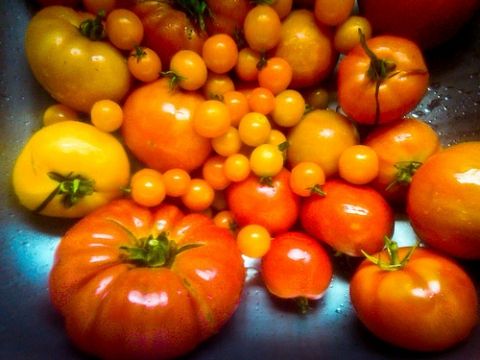
There's only two things money can't buy: True love and home-grown tomatoes. Above, photographer Mark Zilberman proves that you can grow gorgeous tomatoes in the high-altitude Catskills town of Andes. Shared in the Watershed Post Flickr group.
It's September, and the season of bounty is upon us: late-summer vegetables in full profusion, apple harvest just around the corner, tomatoes groaning on the vine.
The season has also brought a bumper crop of in-depth magazine articles about the Catskills local food scene. On August 21, OnEarth Magazine published a long, thoughtful story about the untapped potential of the Catskills as New York City's foodshed. In it, reporter Elizabeth Royte gets treated to Sullivan County dairyman Dave Weiss's best Hank Williams impressions, finds out why Meredith beef farmer Ingimundur Kjarval is learning to love the Internet, and hears produce grower Jack Hoeffner sing the blues about why he can't get his vegetables into the Hunts Point Market in the Bronx.
Along the way, Royte gets a good long look at the many logistical hurdles that still stand between the Catskills' wealth of fresh local food and the hungry mouths of millions of New Yorkers:
With interest in eating high-quality local food (broadly defined by the U.S. Department of Agriculture as food raised or produced within 400 miles of the consumer) higher than at any time since local food was the default, the Catskills are perched on the threshold of perhaps the greatest food-marketing opportunity in North America. Less than three hours away are 22 million stomachs and many thousands of foodies happy to pay $8.59 a pound for Bourbon Red turkey raised within commuting distance. Perhaps even more important for the region are the thousands of city institutions -- schools, hospitals, prisons, senior centers, and shelters -- looking to feed their constituents food that’s fresher and more sustainably grown than what’s currently on offer.
Never have so many individuals, nonprofits, and local politicians been so intent on connecting the bounty of small and medium-size farms with urban consumers. Among these forward thinkers, the message has been internalized: eating more food that’s grown regionally and sustainably will improve public health, protect the environment, and provide economic sustenance to farming communities. (For every dollar spent on a New York State agricultural product, roughly two dollars are returned to the local economy, and for every new job created in food manufacturing, an additional three jobs are supported in food service, food sales, and other related industries.)
But the impediments to this triple-bottom-line harmonic convergence are not, alas, trifling.
It's a challenge for small farmers to process and market their wares, in a food economy built around the needs of the largest producers. But locally, more and more farmers are finding creative ways to take advantage of a burgeoning market for local food -- as Chronogram writer Karin Ursula Edmonson found when she embarked on a tour of the Hudson Valley's best farm-to-table dining recently.
(Aside: There's no way the featured Stone and Thistle Farm, deep in the heart of Delaware County in East Meredith, is even remotely in the Hudson Valley. But, as Royte also points out in the OnEarth story, the Hudson Valley has much slicker branding than the Catskills -- as evidenced by the fact that the Hudson Valley-focused Chronogram exists at all.)
Edmonson finds plenty of field-to-fork fare -- and some unique challenges for menu planners.
Forget seasonal. Menus at farms with tables are of the day, in medias res. “In many instances,” says farmer Cheryl Rogowski, of Rogowski Farm in Pine Island, “I will have harvested the vegetables for the dinner myself that very morning. If the deer ate the carrots last night and carrots were on the menu, the chef needs to change the menu at a moment’s notice.”
It's not just farm-to-table restaurants that have been getting media love lately. A few favorite local restaurants -- and the deliciously glitzy Roxbury Motel -- got a shoutout from the New Haven Register Star last week, whose aptly-named food writer Stephen Fries was equally delighted with the funky-fresh roadside vibe of the Arkville Bread and Breakfast and the upscale backwoods chic of the Peekamoose in Big Indian.
The farmers' markets of Greene County were front and center in the Daily Mail earlier this week. Reporter Susan Campriello writes about the local face of a movement that's been associated with "downstaters," but has plenty of local acolytes:
Medville’s Marjorie McCoy only became a “locavore” a few years ago when the New Baltimore Farmers’ Market opened, which was also around the time she retired from a job in Albany. She started volunteering with the market.
“I thought it would be a great way to really get involved in the community,” she said outside Black Horse Farms, in Coxsackie, this weekend after buying leeks and fennel. “I didn’t really have a big connection to the [locavore] movement and that kind of stuff before.”
McCoy subsequently joined a local community supported agriculture operation and became a vegetarian for health reasons. She buys local food for her anti-inflammatory diet because, she says, she knows what types of pesticides are used.
Looking for more local foods and farms? Check out Pure Catskills' Fresh From The Catskills directory, a six-county online and print guide to the best of what local farms have to offer.












